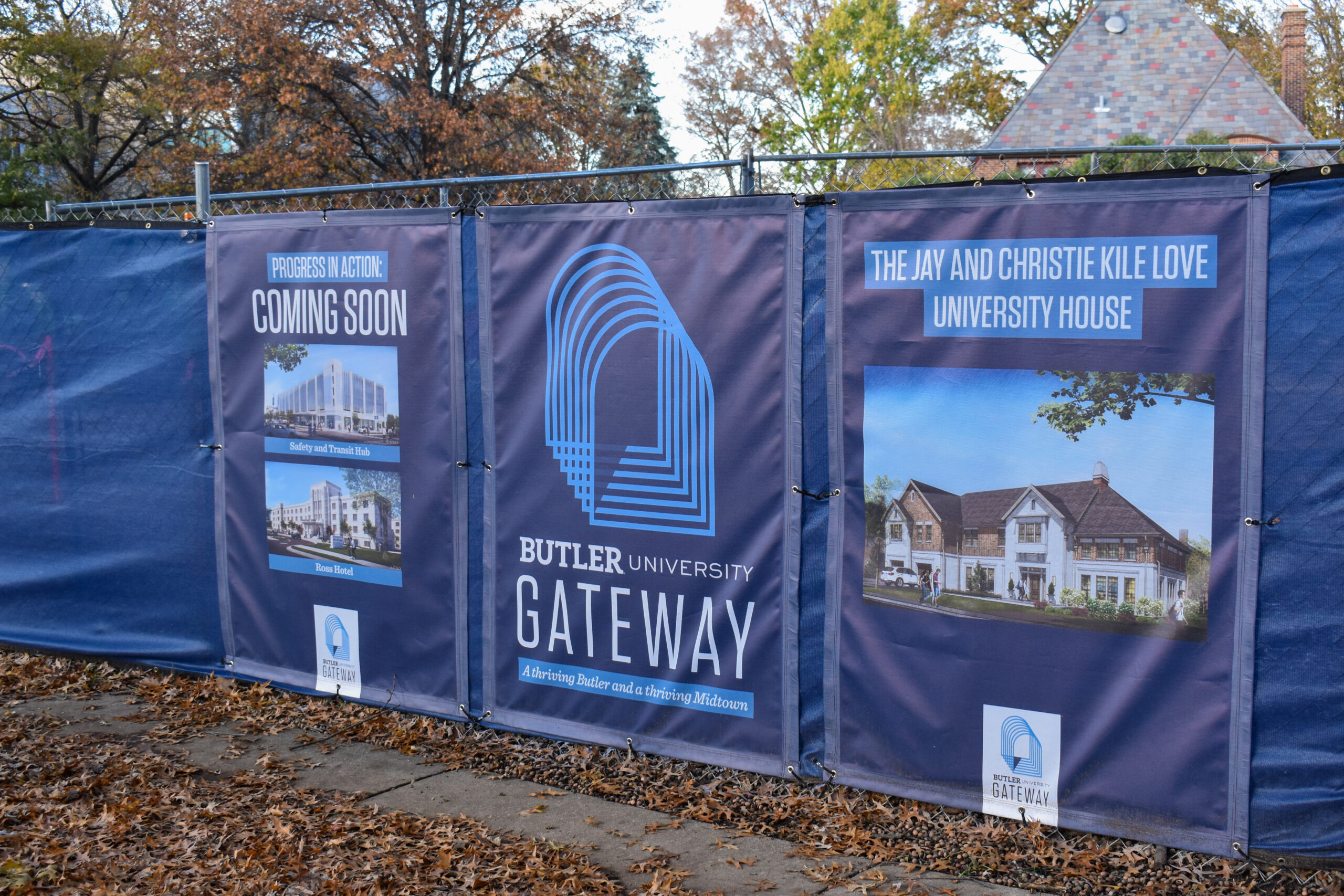Construction site of the Jay and Christie Kile Love House. Photo by Elizabeth Stevenson.
OLLIE FITZGERALD | STAFF REPORTER | ofitzgerald@butler.edu
Construction on the Jay and Christie Kile Love House continues after its start in July 2024 and is expected to be completed by winter 2025. The new house will be located across from Residential College on Sunset Avenue. The current president’s house will remain where it is but there are currently no concrete plans for its future use.
Butler University announced that alumni and trustees Jay and Christie Love donated a $4 million philanthropic gift in August 2022. The donation was made to build a new president’s house, which “will serve as both a prominent, inviting venue for hosting fundraising and other community events and a home for future Butler presidents.”
The project is called the Jay and Christie Kile Love University House and serves as a part of the larger Butler Gateway Project. The Gateway Project aims to improve Butler and the surrounding community to further the future of the University and the Butler-Tarkington neighborhood.
Mark Apple, Butler’s director of strategic communication, keeps key stakeholders involved in the building of the new house and the rest of the Gateway Project and spoke on behalf of President Danko about the new president’s house.
Apple explained that President Danko is incredibly involved in the creation of the Jay and Christie Love House.
“There’s a chance that [Danko] may never even live in this house, but he sees this [project] as very important for the university’s future in terms of fundraising, entertaining and being able to recruit the next president that will come behind him,” Apple said. “For those reasons, he wants to make sure that this is done well, it’s done on time and it’s done on budget.”
Apple also said that Danko wants to keep from “Frankensteining campus” by creating new buildings that don’t match the current university and neighborhood aesthetic.
Michael Lofton, executive director of community and government relations, serves on the Gateway team along with Apple and represents Butler when talking to the Neighborhood Association board of directors.
Lofton explained that the house that was demolished to create this new project was mostly unused and typically only occupied as a temporary guest house for the president’s guests and important VIPs coming to campus, and therefore not necessary to keep in its prior state.
He also explained how Butler worked with the neighborhood to plan and design a house that fit in with the surrounding area.
“The Butler-Tarkington Neighborhood Association expressed concern that we were going to be taking down this historic house and putting up something new that didn’t necessarily fit in the neighborhood,” Lofton said. “We communicated with the neighborhood throughout this entire process to deliver something that [won’t] stick out [and will] fit with the aesthetics of the existing neighborhoods.”
Lofton also explained that the current president’s house isn’t accessible under the Americans with Disabilities Act (ADA), so the new house will be built to comply with the requirements.
“Right now, [President Danko] could not even host students with disabilities, for example, in the house for a party, fundraiser or whatever it might be,” Lofton said. “So [making an ADA-accessible house] was a really big piece of this [project].”
Some Butler students have expressed concerns about projects like the new president’s house being addressed before student concerns, such as parking.
Sophomore strategic communication major Grace Friedberg is especially worried about parking near campus buildings as she and other students enter internships.
“I wish we would prioritize parking over things like the demolition of Ross Hall,” Friedberg said. “I think [the university] needs to realize that a lot of our sophomores, juniors and seniors can’t make it to their internships and jobs because of the lack of parking.”
Other students, like senior theater major Seamus Quinn, are not aware of the Gateway project and other construction projects happening on campus.
Quinn brought up working on Holcomb Gardens — which is being addressed as part of the Gateway project — and renovating other highly used spaces on campus instead.
“A place like Jordan Hall could use a lot of remodeling and [the university] could easily sink $4 million into that,” Quinn said. “[Jordan Hall] is a building that has, I think, a lot more staying power than whatever house they’re building Danko, or whoever the next president is.”
While there are student concerns, Lofton wants students to know that the university is tackling multiple projects and problems at once.
“I hope that students understand that just because we’re doing one thing doesn’t mean we’re not doing something else — just because we are partnering with someone to renovate Ross Hall and make it a hotel doesn’t mean that we’re not also addressing parking,” Lofton said. “We announced plans for a parking garage and student housing before we ever announced the Ross Hall Hotel — so I think that the things that students want us to look at are being looked at. We just ask for their patience as we put this entire plan together.”
Butler’s Gateway project aims to create a lasting impact on campus and the surrounding community by improving the accessibility and longevity of existing buildings and new construction projects.
“The Gateway project is not only envisioning a three-year, five-year [or] 10-year [plan],” Lofton said. “It’s to make sure that we are protecting Butler University and its longevity.”



